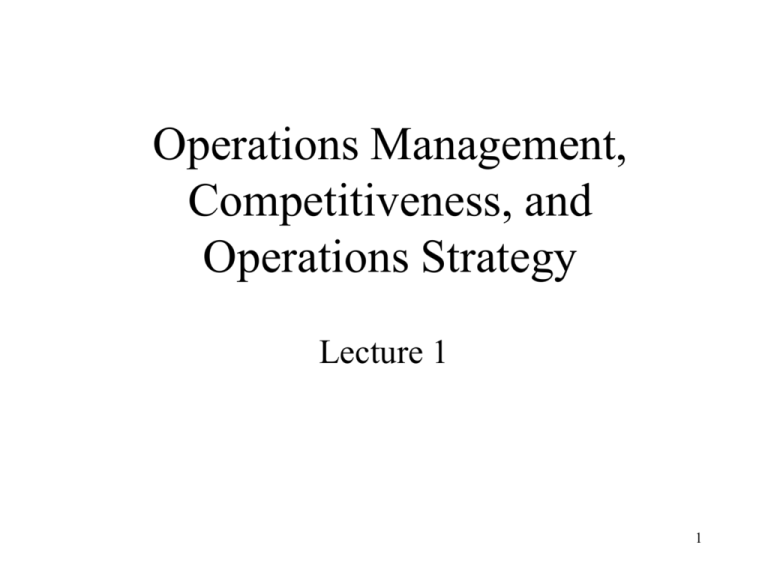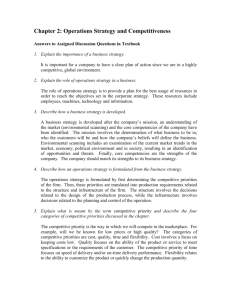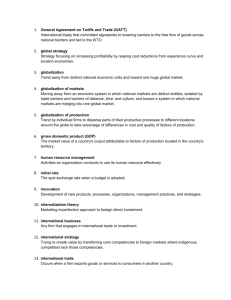lecture 1
advertisement

Operations Management, Competitiveness, and Operations Strategy Lecture 1 1 Operations Function Transformation from inputs to outputs Inputs Labour Materials Capital Operations Outputs Products Services 2 Operations Function Interfaces Personnel Purchasing Operations Marketing Finance 3 Operations Manager • Manages the transformation process – – – – – setup the processes monitors the process makes key decisions develops strategy to manage changes objective: system runs on its own • Employs bulk of the staff • Great opportunities to cut costs and beat competition 4 Operations Management Body of knowledge to help Operations Managers • Modern history – Taylor, Gantt, Hawthorne studies, Henry Ford • 80’s – realization mass production not flexible – insufficient quality control • 90’s – TQM revolution – – – – Adoption of modern IE techniques Globalization, Growth of Service Sector Increased competition 5 Increased Globalization • • • • • Falling trade barriers and protected markets More export business Table 1.3 Internet and e-commerce Remaining bottlenecks: – distribution channels and infrastructure – political stability • Downside: regional problems affect all 6 Increased Service Sector • • • • • Overtakes manufacturing Employs ~80% labour worldwide 75% of US GDP Sole source of net employment gain Same OM techniques being applied 7 Increased Competitiveness • Defined as – degree to which a nation can, under demanding and rapidly changing market conditions, produce goods and services that meet the test of international markets while simultaneously maintaining or expanding the real incomes of its citizens. • Effect of Globalization – more customers – more competitors • Effect of Service Sector – more eagerness to please – increased customer focus 8 Competitiveness Measures • • • • GDP Import/Export Ratio Output/Input Ratio (Productivity) Fig 1.8 9 Changes In Input and Output .. © 2000 by Prentice-Hall Inc Russell/Taylor Oper Mgt 3/e 10 Ch 1 - 25 Trends and Issues in OM Operational Strategies needed to address 1. Industrial Competition 2. Distances 3. Partnership and Alliances 4. Mass Customization 5. Services 6. Quality 7. Flexibility 8. Technology 9. Human Resources concerns 10. Environment 11 Operational Strategy Formulation Must Determine: 1. Primary task of firm 2. Core competencies 3. Order qualifiers and winners 4. Position of the firm in the marketplace 12 Primary Task of Firm • Beyond Vision and mission statements – HR tools for aligning staff on common course – Vision statement: general future direction – Mission statement: current state • Exploit current – competencies for customers – internal competencies • Consider new – products and services – competencies – markets 13 Core Competencies • What are we best at? • What competency beats the competition? • What process (not product) are we good at? – Requires change in focus from What to How 14 Order Qualifiers and Winners • Order Qualifiers – how do we get the customer’s attention • Order Winners – how do we get the purchase from the customer 15 Positioning the Firm How Do We Compete? • Minimize Cost – within quality limits • Maximize Quality (e.g. customer satisfaction) – within cost limits • Maximize Flexibility (e.g. mass customization) – within cost and quality limits • Maximize Speed of Delivery – within cost and quality limits 16 Operational Strategy Must address decisions related to: 1. Products and services 2. Process and Technology 3. Capacity and Facilities 4. Human Resources 5. Quality 6. Sourcing 7. Operating Systems 17 Products and Services • Make-to-order vs. • Make-to-stock vs. • Assemble-to-order 18 Process and Technology • Products – – – – Projects Batch Production Mass Production Continuous Production • Based on – Volume – Standardization • Services – – – – Professional Service Service Shop Mass Service Service Factory • Based on – Labour Intensity – Customization 19 Capacity and Facilities • • • • • • • Demand: All, Average or Given Granularity: Large or small Excess: Overtime, extra shift or subcontract Centralized vs. Distributed General vs. specialized Location: labour, market or supply Globalization: where and how. 20 Human Resources • • • • • • • Skill levels Training Compensation Incentives Profit Sharing Management style Levels of management 21 Quality • • • • Targets Measures Conformance Areas of focus 22 Sourcing • Vertical integration vs.. Outsourcing • Supply management 23 Operating Systems • IT Support for – customers – workers – management • Planning and Control Systems • Inventory Systems • Training in Decision Analysis 24



